Astronomers Spot Massive ‘Eye’ Created By Collision Of Two Distant Galaxies

Collision of two galaxies — each made up of billions of stars — is a cataclysmically violent event. One such event has now been observed by astronomers using the Atacama Large Millimeter/submillimeter Array (ALMA) in Chile.
Although in the cosmic scheme of things, galactic collisions are not uncommon, what makes this particular collision — which took place 114 million light-years from Earth — worth nothing is that the two interacting galaxies have produced a dazzling star formation that resembles a pair of eyelids.
This structure was created when a “tsunami” of stars and gas crashed through the disk of a spiral galaxy known as IC 2163 when it grazed past another spiral galaxy named NGC 2207. According to the authors of a study detailing the observations — published in the latest edition of the Astrophysical Journal — only a handful of galaxies with such ocular structures are currently known to exist.

“Galactic eyelids last only a few tens of millions of years, which is incredibly brief in the lifespan of a galaxy,” lead author Michele Kaufman said in a statement released Friday. “Finding one in such a newly formed state gives us an exceptional opportunity to study what happens when one galaxy grazes another.”
The observation has allowed scientists to study the structure in unprecedented detail, revealing that the gas in the outer portion of IC 2163’s eyelids races inward at speeds of over 100 km (62 miles) a second before aligning itself with the rotation of the galaxy — a phenomenon the researchers likened to a massive ocean wave interacting with the shallows and dumping all its water and sand on the beach.
“Not only do we find a rapid deceleration of the gas as it moves from the outer to the inner edge of the eyelids, but we also measure that the more rapidly it decelerates, the denser the molecular gas becomes,” Kaufman said. “This direct measurement of compression shows how the encounter between the two galaxies drives gas to pile up, spawn new star clusters and form these dazzling eyelid features.”
© Copyright IBTimes 2024. All rights reserved.





















